Remark: Of all the fern species only one or a few specimens are present in the collection.
Seed ferns have fernlike leaves but they are not ferns. They bear seeds
and they belong to the group of gymnosperms. Only very seldom a seed is found
attached to a leaf, but one such a specimen is enough to prove that a particular
leaf shape must be placed into the seed ferns. The majority of the seed ferns
were treeshaped, but some of them grew as lianes.
Previously two groups of seed ferns were distinguished. Nowadays about ten
groups are known from the earliest Devonian till in the Cretaceous. The term
seed fern is at the moment more or less a collective name for all plants
which do not belong to the ferns or to one of the still existing groups of
gynnosperms (conifers, ginkgos, cycads).
 Alethopteris Alethopteris
This is a genus in which the pinnules are broadly attached and are decurrent along the axis. They have a clear, mostly sunken midvein with more or less perpendicular secondary veins. Under the midvein some smaller veins enter the pinnules directly from the rachis as well. The pinnules have an entire margin and in most cases they are connected at the base. |
|
 Alethopteris
decurrens has highly decurrent, very narrow leaflets (around 3 mm),
which stand rather distant from each other and which are mostly connected
at the base. However, free standing pinnules occur also. The veins are very
clear and rather distant. Alethopteris
decurrens has highly decurrent, very narrow leaflets (around 3 mm),
which stand rather distant from each other and which are mostly connected
at the base. However, free standing pinnules occur also. The veins are very
clear and rather distant. |
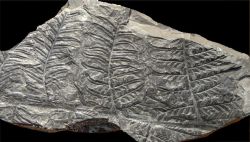 Alethopteris
lonchitica has longer (up to 5 cm) and wider (up to 7 mm) pinnules
than the previous species. They are standing rather close together. Lower
in the pinna the pinnules are less decurrent and sometimes they are
even a bit constricted at the base. The tip of the pinnule is acuminate but
still rounded. Alethopteris
lonchitica has longer (up to 5 cm) and wider (up to 7 mm) pinnules
than the previous species. They are standing rather close together. Lower
in the pinna the pinnules are less decurrent and sometimes they are
even a bit constricted at the base. The tip of the pinnule is acuminate but
still rounded. |
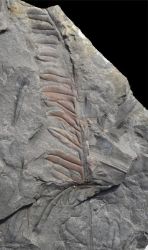 Alethopteris
serlii has somewhat shorter (up to 4 cm) and wider (up to 9 mm) pinnules
than A. lonchitica. The pinnules have more convex margins and they
are broadly rounded. Alethopteris
serlii has somewhat shorter (up to 4 cm) and wider (up to 9 mm) pinnules
than A. lonchitica. The pinnules have more convex margins and they
are broadly rounded. |
|
| Eusphenopteris
This is a genus of seed ferns with pinnules which are divided in rounded, sometimes nearly square, lobes. These lobes are never toothed, but they can be lobed by themselves as well. |
|
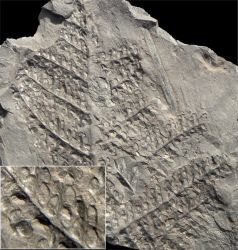 Eusphenopteris
hollandica has pinnules with small, round or oval lobes, which are
a bit vaulted. The top leaflet of a pinna is of about the same size as a
pinnule. Eusphenopteris
hollandica has pinnules with small, round or oval lobes, which are
a bit vaulted. The top leaflet of a pinna is of about the same size as a
pinnule. |
 Eusphenopteris
neuropteroides has pinnules with a bit larger, rounded or oval lobes.
The pinnules are broadly attached. The veins are clearly visible. Eusphenopteris
neuropteroides has pinnules with a bit larger, rounded or oval lobes.
The pinnules are broadly attached. The veins are clearly visible. |
 Eusphenopteris
striata has pinnules with at most five round or oval lobes. The pinnules
are mostly flat and they show a finely striate surface. Eusphenopteris
striata has pinnules with at most five round or oval lobes. The pinnules
are mostly flat and they show a finely striate surface. |
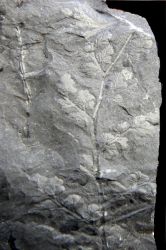 Eusphenopteris
trigonophylla has pinnules which are as a whole a bit triangular
with rounded to triangular lobes. The pinnules are often somewhat
vaulted. Eusphenopteris
trigonophylla has pinnules which are as a whole a bit triangular
with rounded to triangular lobes. The pinnules are often somewhat
vaulted. |
 Mariopteris Mariopteris
This is a genus of climbing seed ferns. The relatively small leaf is forked twice and the pinnae have often a hook at the top. These climbing hooks, however, are not always visible. The pinnules are mostly more or less triangular, but they can also be rounded. They have an entire margin or the margin is lightly undulate. The axes show transverse stripes. The most typical characteristic of Mariopteris is the extra lobe at the base of the pinnules. This extra lobe is best developed in the lowermost pinnule of a pinna. |
|
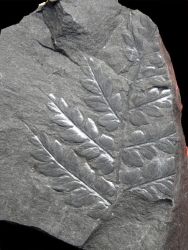 Mariopteris
muricata has stiff, triangular pinnules, which are attached broadly
to the axis. Only the lowermost pinnule is showing an extra lobe at the lower
side. Mariopteris
muricata has stiff, triangular pinnules, which are attached broadly
to the axis. Only the lowermost pinnule is showing an extra lobe at the lower
side. |
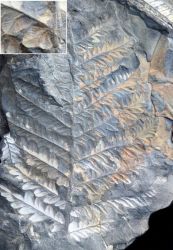 Mariopteris
nervosa has bluntly triangular pinnules with very clear veins. They
are attached obliquely to the axis. Mariopteris
nervosa has bluntly triangular pinnules with very clear veins. They
are attached obliquely to the axis. |
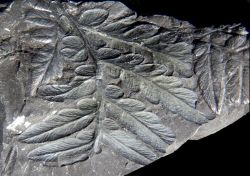 Mariopteris
sauveurii has very elongated pinnules with a somewhat undulate margin.
They can be considered as pinnae with fused pinnules. Mariopteris
sauveurii has very elongated pinnules with a somewhat undulate margin.
They can be considered as pinnae with fused pinnules. |
|
 Neuropteris Neuropteris
This is a genus of seed fern trees with many species. Characteristic is that the oval and tongue-shaped pinnules are attached to the axis in one point. The pinnules in the upper part of a pinna often show a broader attachment. The fronds were divided several times and could be very large. For identification such books as the one by Josten (1991) are needed. |
|
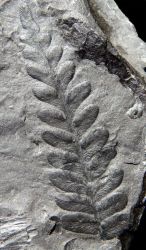 Neuropteris obliqua has pinnae with a large top pinnule,
consisting of several fused pinnules. The pinnules are very variable in shape,
but they have very clear veins. The lateral veins are often a bit flexuous
at the place of branching.
Neuropteris obliqua has pinnae with a large top pinnule,
consisting of several fused pinnules. The pinnules are very variable in shape,
but they have very clear veins. The lateral veins are often a bit flexuous
at the place of branching. Pinnae with large pinnules occur also from time to time. |
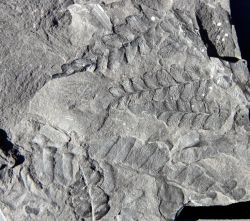 Neuropteris
attenuata has small pinnules (up to 1 cm) with clear, spaced lateral
veins, which are not flexuous at the branching points. Neuropteris
attenuata has small pinnules (up to 1 cm) with clear, spaced lateral
veins, which are not flexuous at the branching points. |
 Neuropteris
bourozii has relatively large, widely rounded pinnules with very
fine veins. From the midvein the lateral veins run upward under a sharp angle,
then going to the margin with a faint bow. They divide a few times. Neuropteris
bourozii has relatively large, widely rounded pinnules with very
fine veins. From the midvein the lateral veins run upward under a sharp angle,
then going to the margin with a faint bow. They divide a few times. |
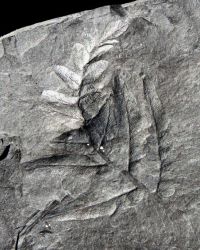 Neuropteris
heterophylla has medium-sized, tongue-shaped pinnules with a midvein
which does not reach the tip of the pinnule. The lateral veins run arched
to the margin. Neuropteris
heterophylla has medium-sized, tongue-shaped pinnules with a midvein
which does not reach the tip of the pinnule. The lateral veins run arched
to the margin. |
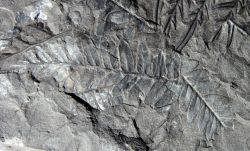 Neuropteris
hollandica heeft medium-sized pinnules in which the midvein stops
at about three quarters of the pinnule. The lateral veins are almost
straight. Neuropteris
hollandica heeft medium-sized pinnules in which the midvein stops
at about three quarters of the pinnule. The lateral veins are almost
straight. |
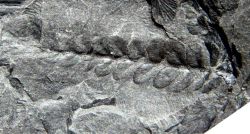 Neuropteris
parvifolia is a species with very small pinnules (mostly up to 6
mm). The lateral veins are a bit spaced and they are somewhat curving. Neuropteris
parvifolia is a species with very small pinnules (mostly up to 6
mm). The lateral veins are a bit spaced and they are somewhat curving. |
 Neuropteris
scheuchzeri is a species with large pinnules. The pinnules are sharply
triangular and they are characterized by a clear short striping between and
over the veins. These structures have always been interpreted as hair, but
some authors have recently suggested that these hairs are in fact the remains
of substances filled with latex or resin. Neuropteris
scheuchzeri is a species with large pinnules. The pinnules are sharply
triangular and they are characterized by a clear short striping between and
over the veins. These structures have always been interpreted as hair, but
some authors have recently suggested that these hairs are in fact the remains
of substances filled with latex or resin. |
 Neuropteris
tenuifolia has relatively large, elongated pinnules with clear veins,
which run close together. Characteristic for the species is a very fine striation
between the veins (powerful magnifying glass!). Neuropteris
tenuifolia has relatively large, elongated pinnules with clear veins,
which run close together. Characteristic for the species is a very fine striation
between the veins (powerful magnifying glass!). |
| Linopteris This genus is characterized by a reticulate venation. The pinnules are also somewhat bent upwards. The pinnules are attached in opposite position to the axis and a complete pinna is terminated by two endpinnules. It is remarkable that in Bode (1927) this species is mentioned frequently, whereas in the collection described here only one specimen is present. |
 Linopteris
neuropteroides has rather large pinnules (up to 4 cm but mostly 2
cm). The meshes of the reticulate venation are very narrow and elongated.
The midvein disappears in the middle of the pinnule. Linopteris
neuropteroides has rather large pinnules (up to 4 cm but mostly 2
cm). The meshes of the reticulate venation are very narrow and elongated.
The midvein disappears in the middle of the pinnule. |
| Neuralethopteris With regard to the leaf shape this genus is an intermediate between Neuropteris and Alethopteris. In most cases the pinnules are constricted at the base (Neuropteris-like), though decurrent pinnules also occur. Shape and venation, however, resemble most those of Alethopteris: the pinnules are long and narrow, the midvein runs up to the top and the lateral veins are more or less perpendicular on the margin. |
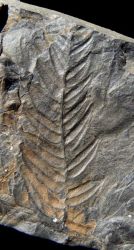 Neuralethopteris
schlehanii: the pinnules are long and narrow, the midvein
runs up to the top and the lateral veins are more or less perpendicular on
the margin. Neuralethopteris
schlehanii: the pinnules are long and narrow, the midvein
runs up to the top and the lateral veins are more or less perpendicular on
the margin. |
| Palmatopteris
This is a genus with deeply incised, hand-shaped (palmate, digitate) pinnules. |
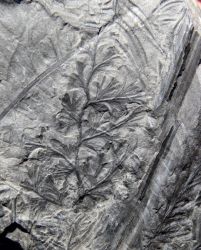 Palmatopteris
furcata has pinnules with very narrow lobes (up to 1 mm). In some
specimens the lobes are more fused and the incision is not so deep. Sometimes
one of the lobes is hookshaped. Therefore it is assumed that this was a climbing
plant. Palmatopteris
furcata has pinnules with very narrow lobes (up to 1 mm). In some
specimens the lobes are more fused and the incision is not so deep. Sometimes
one of the lobes is hookshaped. Therefore it is assumed that this was a climbing
plant. |
| Paripteris This is a small genus with species with rather large, tongue-shaped, feather-veined, opposite pinnules with a rounded apex. The pinnules are mostly somewhat bent upward. Special is that a pinna has two endpinnules. |
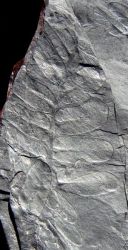 Paripteris
pseudogigantea has pinnules which in most cases are not longer than
2 cm. This separates the species from P. gigantea which has pinnules
of up to 4 cm. The latter species has also a shorter midvein (up to the middle
of the pinnules). The pinnules are mostly found detached. Paripteris
pseudogigantea has pinnules which in most cases are not longer than
2 cm. This separates the species from P. gigantea which has pinnules
of up to 4 cm. The latter species has also a shorter midvein (up to the middle
of the pinnules). The pinnules are mostly found detached. |
| Reticulopteris This genus resembles Neuropteris, but the venation is strikingly reticulate. The pinnules are strongly constricted at the base. |
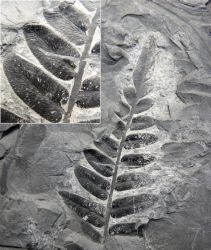 Reticulopteris
muensteri has rather large pinnules, of which the smaller ones are
mostly tongue-shaped and the larger ones more triangular. This is the only
one species of this genus in the region. Circular, large
Cyclopteris-leaves with a reticulate venation are also from this
species. Reticulopteris
muensteri has rather large pinnules, of which the smaller ones are
mostly tongue-shaped and the larger ones more triangular. This is the only
one species of this genus in the region. Circular, large
Cyclopteris-leaves with a reticulate venation are also from this
species. |
Cyclopteris   This
is the name of large, (mostly) rounded bracteal leaves, which were attached
to the base of a 'feather' of a frond of a seed fern. They are only seldom
found attached. See the picture on the right for the place of
Cyclopteris. This
is the name of large, (mostly) rounded bracteal leaves, which were attached
to the base of a 'feather' of a frond of a seed fern. They are only seldom
found attached. See the picture on the right for the place of
Cyclopteris. |
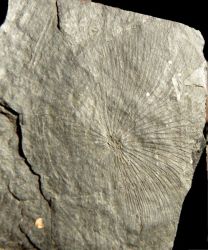 Dolerophyllym
goeppertii is the name of a circular leaf with veins which are dividing
at a sharp angle. The systematic place of this (rare) fossil is not yet
clear. Dolerophyllym
goeppertii is the name of a circular leaf with veins which are dividing
at a sharp angle. The systematic place of this (rare) fossil is not yet
clear. |
| Seeds In by far most cases seeds are found detached from the leaves. An attached seed can be of scientific importance. Identification of detached seeds is often difficult because of the lack of clear characteristics. An attempt can be made with Cleal & Thomas (1994) in which booklet a complete chapter has been dedicated to this subject. |
|
Hexagonocarpus hookeri.
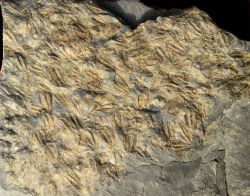 Seeds with six clear ribs, of which usually only three or four in compressed
material are visible.
Seeds with six clear ribs, of which usually only three or four in compressed
material are visible. |
 Carpolithus
membranaceous. Small oval seeds with irregular stripes. Carpolithus
membranaceous. Small oval seeds with irregular stripes. |
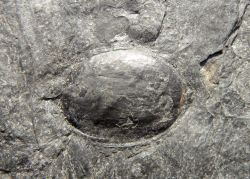 Carpolithus
sp. A rather large seed without wings or ornamentation. Carpolithus
sp. A rather large seed without wings or ornamentation. |
 Holcospermum
sp. Seeds without wings but with more than six ribs. Holcospermum
sp. Seeds without wings but with more than six ribs. |
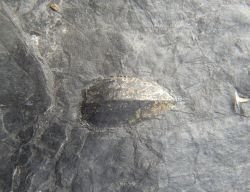 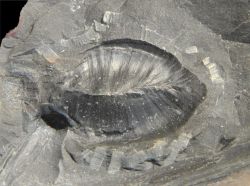 Trigonocarpus
sp. Oval, in transverse section triangular seeds with three clear ribs
and sometimes another three less visible ones. Trigonocarpus
sp. Oval, in transverse section triangular seeds with three clear ribs
and sometimes another three less visible ones. |
|